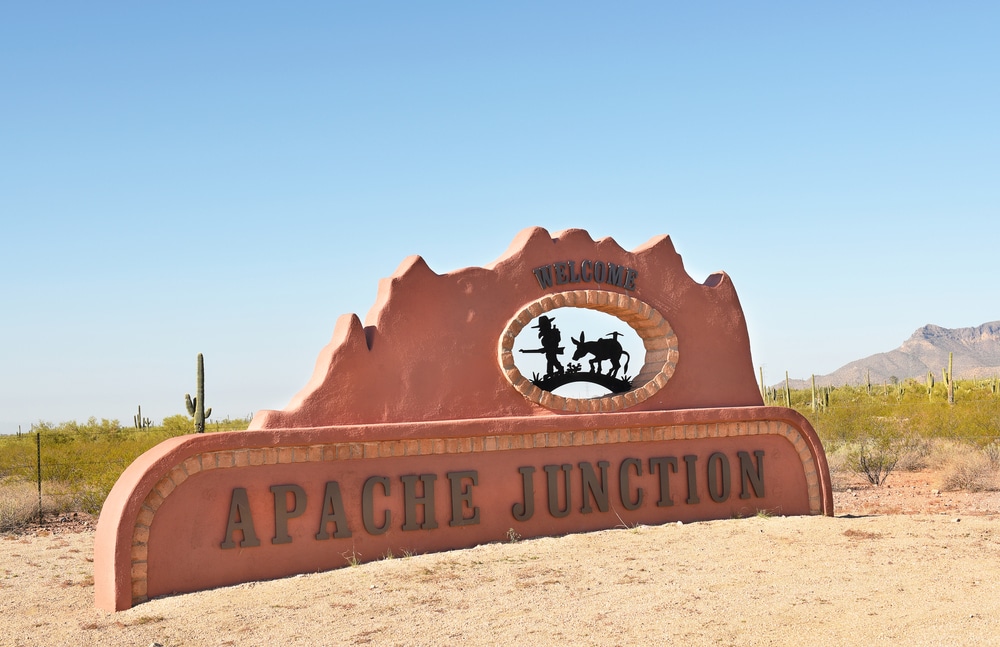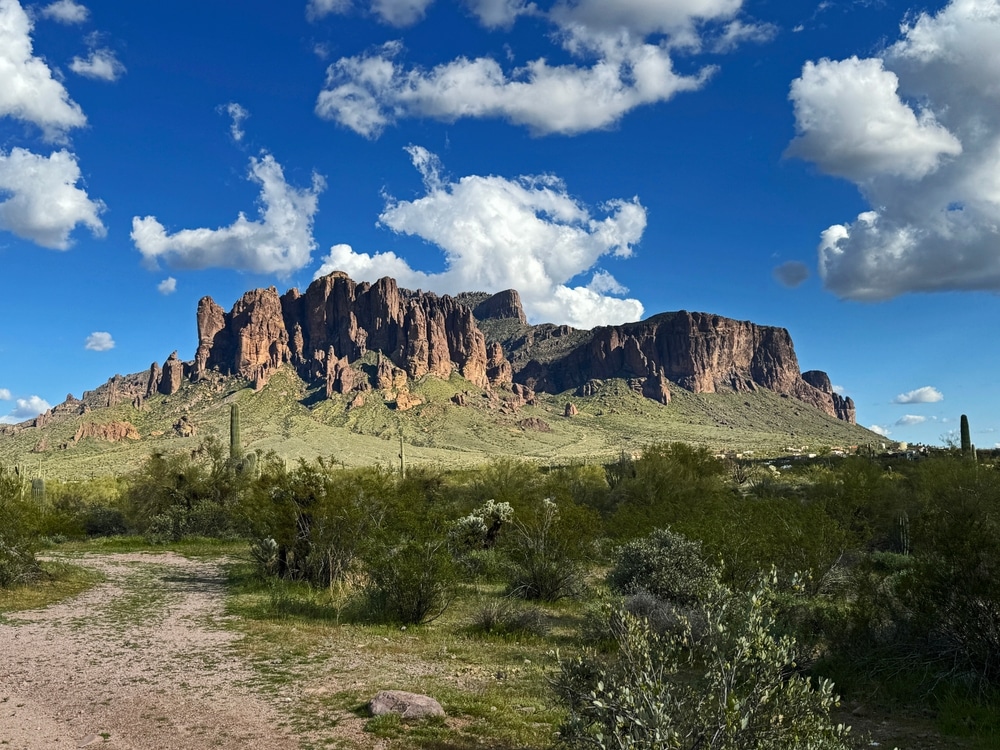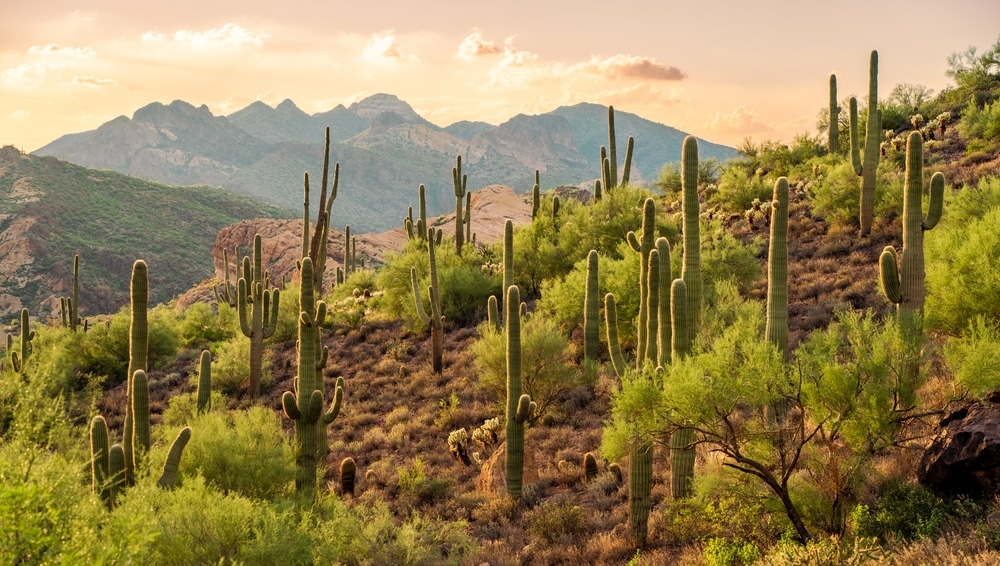- Privacy
- Terms
- Stay Connected
Nestled at the base of the majestic Superstition Mountains in central Arizona, Apache Junction stands as a gateway to the wilderness and a bridge between metropolitan Phoenix and the rugged Sonoran Desert. Located approximately 35 miles east of Phoenix in Pinal County, this community of roughly 43,000 residents embodies the spirit of the American Southwest. The city’s dramatic setting is defined by saguaro-studded landscapes, dramatic mountain vistas, and the legendary Lost Dutchman’s Gold Mine that has drawn prospectors and adventure-seekers for generations. Apache Junction’s population reflects a diverse mix of retirees seeking winter warmth, young families attracted by affordable housing, and descendants of pioneering homesteaders, creating a unique blend of perspectives and traditions. What distinguishes Apache Junction from neighboring communities is its steadfast commitment to preserving its frontier heritage while embracing its evolution from a small mining outpost to a vibrant desert community that celebrates its position at the crossroads of myth and modernity.

Apache Junction’s desert terrain creates an ideal mountain biking playground. The Hawes Loop System offers 20+ miles of interconnected trails featuring technical rock gardens and flowing singletracks with breathtaking mountain views. Gold Canyon provides challenging climbs and exhilarating descents. The riding season peaks October through May when temperatures moderate. Local shops offer rentals and trail advice. The cactus-lined routes demand proper equipment but reward riders with an authentic Sonoran Desert experience.
Experience the Arizona desert as pioneers did through guided horseback rides. Local stables offer excursions ranging from one-hour introductory trails to full-day adventures into the Superstition Mountains. Riders meander through saguaro forests and rolling foothills while guides share tales of gold mining history and desert ecology. Sunset rides provide magical mountain views painted in orange and pink hues. Most outfitters accommodate all skill levels in this authentic western experience.

When temperatures soar, cool off at nearby Canyon Lake and Saguaro Lake. Both offer designated swimming areas with stunning desert mountain backdrops. Canyon Lake’s boulder-lined beaches provide picturesque spots for families, while Saguaro Lake features the popular Butcher Jones Beach with picnic facilities. The refreshing waters provide perfect relief from summer heat, with water temperatures reaching the mid-70s in peak season.

Apache Junction offers photographers extraordinary desert landscapes dominated by the iconic Superstition Mountains. Capture golden hour light as it illuminates the jagged peaks, transforming them into glowing sentinels. Spring brings desert wildflowers creating colorful foregrounds, while summer monsoons deliver dramatic storm clouds and lightning opportunities. Wildlife photographers can find roadrunners, coyotes, and diverse bird species. Historic structures at Goldfield Ghost Town provide rustic architectural subjects against mountain backdrops, especially appealing in early morning light

Experience starlit desert nights by camping in and around Apache Junction. Lost Dutchman State Park offers 134 developed campsites with amenities like fire rings, picnic tables, and modern restrooms. More adventurous campers can find primitive sites in Tonto National Forest. Fall through spring provide ideal camping weather with comfortable temperatures. Summer campers should prepare for heat but enjoy remarkably cool evenings. The minimal light pollution delivers spectacular stargazing opportunities, while dawn brings stunning silhouettes of the Superstition Mountains against the brightening sky.

Explore rugged backcountry on guided Jeep adventures into the Superstition Mountains. Knowledgeable guides navigate challenging terrain while sharing stories of the Lost Dutchman’s Gold Mine and pointing out native plants and wildlife. Tours range from two-hour excursions to full-day expeditions visiting abandoned mining camps and Native American ruins. These off-road adventures access remote areas inaccessible to regular vehicles, providing unique perspectives of Apache Junction’s dramatic landscape.

The Superstition Mountains offer spectacular trails for all skill levels. Lost Dutchman State Park features popular routes like Treasure Loop and Siphon Draw, revealing stunning desert vistas and geological formations. Spring hikers enjoy colorful wildflower displays, while fall and winter provide ideal temperatures. Many paths connect to legends of the Lost Dutchman’s Gold Mine, adding historical intrigue to your adventure. Remember to carry ample water and start early during warmer months.

Step back in time at Goldfield Ghost Town, a reconstructed 1890s mining camp. Wander boardwalks past period buildings housing shops, saloons, and museums. Experience underground mine tours, witness gunfight reenactments, and ride the narrow-gauge railroad. Pan for gold, watch blacksmithing demonstrations, or enjoy zipline adventures. The historic buildings and costumed interpreters create an immersive Old West atmosphere, offering a glimpse into Apache Junction’s gold rush heritage just minutes from modern conveniences.

The jagged silhouette of the Superstition Mountains dominates Apache Junction’s eastern horizon, creating a dramatic backdrop for the community. These rugged peaks rise abruptly from the desert floor, reaching elevations over 5,000 feet. Weavers Needle, a distinctive volcanic spire, serves as the range’s most recognizable landmark. The mountains’ striking geology features exposed volcanic layers displaying vibrant reds, yellows, and purples that glow dramatically at sunrise and sunset. Beyond their scenic beauty, these mountains hold deep cultural significance for indigenous peoples and stand as the centerpiece of numerous local legends.

Named after the fabled lost gold mine, this park provides excellent access to the Superstition wilderness. The park offers a network of well-maintained trails suitable for various abilities, from the accessible Native Plant Trail to the challenging Siphon Draw Trail leading toward Flatiron Peak. Camping facilities include both developed sites with amenities and primitive areas for a more rustic experience. During spring, the park explodes with wildflower displays featuring poppies, lupines, and brittlebush. Rangers conduct interpretive programs focusing on desert ecology, survival skills, and the enduring mystery of the Lost Dutchman’s gold.

This reconstructed 1890s mining camp offers an immersive glimpse into Arizona’s territorial period. Originally a booming gold mining settlement, the town was abandoned after ore deposits played out. Today’s recreation features period-accurate buildings including the Mammoth Saloon, bordello, bakery, and assay office. Attractions include underground mine tours, narrow-gauge railroad rides, and weekend gunfight performances. Artisans demonstrate traditional crafts including blacksmithing and leatherworking. The Superstition Mountain Museum within the complex houses mining artifacts, historical photographs, and exhibits detailing local indigenous cultures.

| Feature | Details |
|---|---|
| Location | Eastern edge of Phoenix metropolitan area, Pinal County/Maricopa County |
| Founded | Established in 1922, incorporated in 1978 |
| Population | Approximately 42,000 permanent residents; swells in winter with seasonal residents |
| Elevation | 1,722 feet (525 m) |
| Geography | Located at the base of the Superstition Mountains |
| Climate | Hot desert climate with mild winters and very hot summers |
| Signature Landmark | Superstition Mountains, particularly Weaver’s Needle formation |
| Famous Legend | Lost Dutchman’s Gold Mine, supposedly hidden in the Superstition Mountains |
| Major Parks | Lost Dutchman State Park, Superstition Mountain Museum |
| Recreation | Hiking, camping, mountain biking, horseback riding, off-roading |
| Major Trails | Treasure Loop Trail, Siphon Draw Trail to Flatiron Summit |
| Economy | Tourism, service industries, seasonal economy, retirement communities |
| Seasonal Pattern | “Snowbird” destination (population increases significantly in winter months) |
| Cultural Events | Lost Dutchman Days (annual rodeo and festival), Apache Junction Mounted Rangers events |
| Film History | Backdrop for numerous Western films at the nearby Apacheland Movie Ranch (now museum) |
| Points of Interest | Goldfield Ghost Town, Canyon Lake, Tortilla Flat, Dolly Steamboat |
| Nearby Attractions | Tonto National Forest, Apache Trail scenic drive, Roosevelt Lake |
| Transportation | State Route 88 (Apache Trail), US 60 (Superstition Freeway) |
| Housing | Mix of permanent residences, retirement communities, RV parks, and mobile homes |
| Education | Apache Junction Unified School District, Central Arizona College (nearby) |
Apache Junction serves as the eastern gateway to the Phoenix metropolitan area and is best known for its proximity to the mysterious Superstition Mountains. The city blends its colorful Wild West heritage with modern development, creating a unique atmosphere that attracts both tourists and retirees seeking the desert lifestyle. Its identity remains closely tied to the legends of hidden gold and the rugged desert landscape that surrounds it.
The land now known as Apache Junction was first home to indigenous peoples, particularly the Akimel O’odham (Pima) and the Apache, who navigated these desert landscapes for centuries before European contact. Archaeological evidence suggests human habitation in the region dates back thousands of years, with ancient Hohokam irrigation canals still visible in parts of the surrounding desert.
The area gained prominence in the late 19th century following Jacob Waltz’s alleged discovery of an immensely rich gold deposit in the nearby Superstition Mountains. Known as the “Lost Dutchman’s Gold Mine,” this legendary treasure has never been confirmed but spurred significant settlement in the region as prospectors arrived with dreams of striking it rich.
Apache Junction itself began to form in the early 1900s as a small settlement along the Apache Trail, a rugged stagecoach route constructed to transport materials for the building of Roosevelt Dam. The completion of this trail in 1905 opened the region to tourism and further settlement. The town was officially named in 1923 when the first post office was established at the junction of the Apache Trail and the road to Globe.
The community experienced significant growth following World War II, particularly in the 1950s and 1960s when retirees discovered its mild winter climate. The town incorporated in 1978, marking its transition from an unregulated outpost to an organized municipality.
Today, Apache Junction preserves its frontier history through institutions like the Superstition Mountain Museum and the annual Lost Dutchman Days event. Historical artifacts, from mining equipment to pioneer homesteads, are carefully preserved, while local storytellers and historians ensure that the colorful tales of lost gold mines and frontier justice remain vibrant parts of the community’s identity.
Apache Junction’s cultural identity represents a fascinating blend of Native American traditions, Hispanic influences, Wild West frontier spirit, and modern Southwestern values. This cultural tapestry reflects the diverse peoples who have called this desert region home across centuries.
Indigenous heritage remains visible through traditional crafts like basketry and pottery that are celebrated at local markets and museums. The Akimel O’odham agricultural techniques and Apache survival knowledge continue to influence local appreciation for desert plants and sustainable living practices. Hispanic cultural elements blend seamlessly into daily life through architecture, cuisine, and seasonal celebrations that honor this important component of Arizona’s heritage.
The dominant cultural narrative, however, remains rooted in Apache Junction’s frontier past. The mythology of the Wild West—prospectors, cowboys, and rugged individualists—continues to shape community identity. This frontier ethos is evident in local businesses, street names, and the popular western wear still commonly seen around town.
Cultural preservation efforts are spearheaded by organizations like the Apache Junction Historical Society and the Superstition Mountain Museum, which maintain archives of oral histories, photographs, and artifacts. Local educational programs encourage younger generations to connect with these traditions through hands-on experiences and intergenerational storytelling.
Language in Apache Junction reflects its cultural diversity, with Southwestern colloquialisms, Spanish phrases, and mining terminology woven into everyday speech. Terms like “snowbird” (winter visitor) and “desert rat” (long-term desert dweller) reflect the community’s seasonal rhythms and identity.
Over time, Apache Junction has evolved from a predominantly mining and ranching economy to embrace tourism and service industries, bringing new cultural influences. The influx of retirees from across the United States has created a more diverse community, while maintaining strong connections to Western heritage that residents proudly preserve as their distinguishing cultural legacy.
Apache Junction’s artistic soul is deeply influenced by its dramatic desert landscape and rich frontier mythology. Local artists frequently draw inspiration from the play of light on the Superstition Mountains, the diverse desert flora, and the legendary tales that permeate the region.
The community boasts a distinctive Southwestern artistic tradition characterized by vibrant desert landscapes, Native American-inspired designs, and cowboy art that romanticizes the frontier experience. Turquoise and copper jewelry making, influenced by Native American traditions, thrives among local artisans who incorporate modern design elements while honoring traditional techniques.
Notable artists from the community include painter Ted DeGrazia, who captured the spirit of the Southwest through colorful, impressionistic works that celebrated desert life and cultures. Contemporary artists like glass sculptor Dale Chihuly have found inspiration in the dramatic desert light and terrain, while numerous local painters, potters, and photographers continue this artistic tradition.
The Apache Junction Multi-Generational Center serves as a cultural hub, offering art classes and exhibition space for emerging talents. The Superstition Mountain Museum hosts rotating galleries that showcase both historical artifacts and contemporary interpretations of regional themes. Several independent galleries and artist cooperatives along Apache Trail provide space for artists to display and sell their work directly to visitors and residents.
Community art programs flourish through organizations like the Apache Junction Arts Council, which coordinates public art initiatives and youth education programs designed to foster creativity and appreciation for local artistic traditions. The Desert Rose Theater brings performing arts to the community through productions that often celebrate regional stories and characters.
Outdoor installations, including desert sculpture gardens and painted murals depicting historical scenes, transform public spaces into art experiences that reflect the community’s unique sense of place. Many local artists cite the extraordinary quality of desert light, dramatic geological formations, and the mystique of the Superstition Mountains as essential elements in their creative process, creating a distinctly Apache Junction aesthetic that carries forward its artistic legacy.
Apache Junction’s annual event calendar reflects its deep connection to Western heritage, desert environment, and diverse cultural influences. These gatherings serve as touchstones for community identity, economic vitality, and cultural preservation, drawing together residents and visitors in celebration of what makes this desert community special.
Lost Dutchman Days, established in 1964, honors the legendary gold mine that put Apache Junction on the map. This three-day February event features one of Arizona’s top-rated rodeos alongside a carnival, parade, and arts festival. Attendees can experience authentic cowboy traditions from barrel racing to bull riding while local historians share tales of the elusive gold mine. The event raises significant funds for local charities while preserving the community’s frontier spirit through friendly competitions that celebrate horsemanship and Western skills.
This winter celebration connects residents to the region’s natural and cultural heritage through guided hikes, native plant workshops, and storytelling sessions. Traditional foods like mesquite flour tortillas and prickly pear preparations highlight the desert’s bounty. The event brings together tribal representatives, local ranchers, and conservation groups to share knowledge about sustainable desert living. Originally a small gathering of history enthusiasts, it has evolved into a major educational festival that strengthens intergenerational understanding of Apache Junction’s unique environment.
This unique celebration showcases Apache Junction’s connection to transportation history with model train exhibitions, historic railroad artifacts, and live steam engine demonstrations. Local model railroad enthusiasts display intricate recreations of regional landscapes alongside professional exhibitions. The event attracts rail enthusiasts from across the Southwest, generating tourism revenue while educating visitors about the railroad’s crucial role in developing the region. Children particularly delight in the hands-on learning opportunities and train rides available throughout the weekend.
This heartwarming spring event brings together pet lovers for a day of activities supporting local animal rescue organizations. Hundreds of volunteers coordinate pet adoptions, veterinary services, and education about desert wildlife. The event features competitions like the popular “Desert Dog Dash” and costume contests that reflect local creativity. Starting as a small fundraiser, Paws in the Park now attracts thousands annually, demonstrating the community’s commitment to animal welfare while strengthening bonds between various neighborhood groups through collaborative volunteer efforts.
This relatively new monthly event established in 2017 showcases contemporary Apache Junction through local food trucks, craft beer gardens, and artisan markets featuring modern desert-inspired goods. The market intentionally caters to younger residents and families with activities like outdoor movie screenings and live indie music performances. Unlike older community traditions, this evening event embraces Apache Junction’s emerging identity as a creative, accessible alternative to nearby metropolitan areas, attracting new visitors while giving established residents fresh reasons to appreciate their evolving community.
Apache Junction proudly embraces its nickname “AJ,” reflecting the familiar, close-knit nature of the community. The unofficial slogan “Where the Desert Meets the Mountains” captures both the physical setting and metaphorical position as a threshold between civilization and wilderness. Locals often describe themselves as “desert dwellers” or “Superstition folks,” identifiers that connect them to their distinctive landscape.
The community values self-reliance, neighborliness, and authenticity—traits derived from its frontier heritage. There’s a palpable pride in remaining somewhat untamed compared to nearby Phoenix suburbs, with residents often expressing appreciation for fewer regulations and more personal freedom. This independent spirit coexists with a strong ethic of mutual support, particularly evident during summer heat emergencies when neighbors regularly check on elderly residents.
Architecturally, Apache Junction displays an eclectic mix that tells its historical story. Older neighborhoods feature modest ranch homes and distinctive southwestern styles with adobe influences, flat roofs, and enclosed courtyard designs that maximize shade. Mobile home communities, particularly popular among seasonal residents, reflect the community’s practical, affordable approach to desert living. Newer developments incorporate more modern Southwestern aesthetics with desert-adapted landscaping and energy-efficient designs, though residents have consistently resisted high-density development through zoning regulations designed to preserve mountain views and the community’s spacious character.
When describing Apache Junction to outsiders, residents typically emphasize its spectacular natural setting, affordable lifestyle, and strong sense of belonging. They often proudly mention the community’s resilience through economic challenges and its refusal to be absorbed into metropolitan Phoenix’s expanding footprint. While acknowledging its reputation as a sometimes rough-edged frontier town, locals point to the authentic character this creates—a place where people are accepted for who they are rather than their status or background. This unpretentious quality forms the cornerstone of Apache Junction’s distinctive community identity.
Apache Junction operates under a council-manager form of government, with a mayor and six council members elected at large to serve staggered four-year terms. The City Manager, appointed by the council, oversees daily operations and implements council policies. This structure has provided stability since the city’s incorporation in 1978, though it evolved from more informal community leadership during its early development.
The city maintains active citizen advisory boards focused on areas like planning and zoning, parks and recreation, and public safety. These volunteer committees provide regular residents with meaningful input into municipal decisions, reflecting the community’s grassroots approach to governance. City Council meetings are known for robust public participation, with meetings often extending late into the evening as citizens voice concerns about everything from water conservation to development proposals.
The Apache Junction Chamber of Commerce plays a significant role in community leadership, particularly regarding economic development initiatives and promotion of local businesses. The Chamber’s annual leadership program has trained dozens of emerging community leaders, creating a pipeline of engaged citizens prepared for civic involvement.
Grassroots organizations like the Apache Junction Food Bank, Superstition Community Food Alliance, and various neighborhood associations address specific community needs through volunteer efforts. The “AJ PAWS” animal welfare group exemplifies this community-led approach, having successfully advocated for improved animal control services and educational programs about desert wildlife.
Particularly notable is the Apache Junction Citizen Leadership Institute, which educates residents about municipal operations and encourages civic engagement. This program has significantly increased volunteer participation in city initiatives and community improvement projects, from desert cleanup events to youth mentoring programs. The city’s responsive approach to citizen input has fostered unusually high levels of trust in local government, creating a collaborative atmosphere that residents frequently cite as one of Apache Junction’s strengths.
Apache Junction’s economy has transformed dramatically from its origins as a mining outpost and stagecoach stop. While gold mining initially drove settlement, today’s economic foundation rests primarily on tourism, retail, healthcare, and services for the sizeable retiree population.
The community experiences distinct seasonal economic rhythms, with winter visitors from colder northern states (affectionately called “snowbirds”) boosting local businesses from October through April. These seasonal residents substantially impact the retail, restaurant, and healthcare sectors, creating a cyclical pattern that local entrepreneurs have learned to navigate through diverse business strategies.
Small businesses form the backbone of Apache Junction’s economy, with the Apache Trail commercial corridor hosting numerous family-owned establishments. The entrepreneurial spirit remains strong, with new businesses regularly emerging to serve both longstanding needs and evolving market opportunities. The Chamber of Commerce provides support through networking events, training programs, and promotion efforts specifically designed for small enterprise development.
Unique local industries include desert landscape services specializing in native plants, custom Western wear production, artisanal crafts related to the area’s mining heritage, and outdoor recreation services. These enterprises typically emphasize authentic connections to regional identity and resources, distinguishing them from generic suburban businesses.
Economic challenges include managing seasonal fluctuations, maintaining infrastructure with a limited tax base, and creating sufficient year-round employment opportunities for younger residents. The community has responded by developing tourism initiatives that extend beyond winter months and diversifying its economic base through modest industrial development in designated zones.
Apache Junction’s economic future likely depends on balancing development with preserving the natural amenities and frontier character that attract both visitors and new residents. Community leaders have prioritized sustainable growth that respects environmental resources while creating economic opportunities aligned with local values and regional identity.
Apache Junction’s educational landscape centers around the Apache Junction Unified School District, which serves approximately 3,600 students through four elementary schools, one middle school, and one high school. The district emphasizes connections to local heritage through specialized programming, including award-winning agricultural education and natural resource management courses that draw upon regional traditions of ranching and desert stewardship.
Central Arizona College maintains a satellite campus in Apache Junction, providing accessible higher education opportunities focused on workforce development and transfer pathways to four-year institutions. The campus offers specialized programs in desert sustainability, tourism management, and healthcare services that align with regional employment needs.
Educational initiatives unique to Apache Junction include the Superstition Mountain Heritage Program, which brings local historians and tribal representatives into classrooms to share cultural knowledge and traditional practices. The school district’s “Desert Explorers” curriculum integrates science education with field experiences in the surrounding Sonoran Desert, creating hands-on learning opportunities that connect students with their environment.
The Apache Junction Public Library serves as an important educational resource beyond traditional schooling, offering community workshops on topics ranging from desert gardening to local history research. Its substantial Southwestern history collection provides valuable resources for residents and researchers interested in regional heritage.
Intergenerational learning flourishes through programs like “Experience Counts,” which brings retired professionals into classrooms to share expertise, and “Heritage Apprenticeships” that pair youth with elder artisans to preserve traditional crafts and skills. These initiatives reflect the community’s commitment to honoring wisdom across generations while preparing young people for future opportunities aligned with local values and needs.
Apache Junction’s identity is inextricably linked to its dramatic natural setting at the base of the Superstition Mountains. Residents express a profound connection to this landscape, with many citing the mountain views and desert ecosystem as primary reasons for choosing to live in the community. This relationship shapes daily routines, recreational choices, and a shared understanding of environmental stewardship.
Traditional knowledge of desert plants remains alive through both formal education and informal community sharing. Many residents maintain knowledge of native plant uses, including medicinal applications of creosote and jojoba, food preparation using mesquite pods and prickly pear, and practical applications of yucca fibers. Local nurseries specialize in native species, and the community’s landscaping preferences strongly favor desert-appropriate plants that conserve water while providing wildlife habitat.
Environmental conservation takes various forms, from the city’s dark sky ordinances that protect stargazing opportunities to citizen-led cleanup initiatives along desert trails. The Apache Junction Groundwater Sustainability Committee brings together diverse stakeholders to address water management, reflecting the community’s understanding of this precious desert resource. Annual events like “Treasuring the Superstitions” combine recreation with education about fragile desert ecosystems.
Outdoor activities deeply rooted in local tradition include prospecting (still practiced by hobbyists searching for the legendary Lost Dutchman’s Gold), desert plant harvesting during seasonal cycles, and horsemanship that connects to the community’s ranching heritage. The extensive trail system through the Superstition Wilderness provides accessible hiking opportunities that many residents use weekly, creating a community of trail enthusiasts who share knowledge and experiences. Backyard wildlife feeding and observation represent another connection to the natural environment, with hummingbird and quail feeding stations common in local yards.
This intimate relationship with the natural landscape features prominently in community identity, with residents often serving as informal ambassadors educating visitors about responsible desert recreation and wildlife appreciation. The dramatic sunrise and sunset views against the Superstition Mountains create daily community rituals, with many residents gathering at viewpoints to witness these natural spectacles together.
Apache Junction’s culinary identity represents a distinctive blend of Southwestern traditions, cowboy cooking, and adaptations to desert ingredients. The community’s food heritage reflects its position at the crossroads of diverse cultural influences while emphasizing resourcefulness and connection to the local environment.
Traditional dishes with historical significance include Sonoran wheat tortillas, mesquite flour baked goods, and slow-cooked meats that reflect both Native American and ranching traditions. Prickly pear harvest remains a seasonal activity for many residents, who gather the ruby fruits for traditional syrups, jellies, and the local specialty “prickly pear lemonade” that appears at community events and family gatherings. Chiltepin and other wild desert peppers feature prominently in local cooking, harvested from plants that have adapted to the harsh Sonoran Desert conditions.
“Cowboy cooking” maintains a strong presence, particularly in the form of Dutch oven cooking traditions preserved through community cook-offs and demonstrations at events like Lost Dutchman Days. These techniques connect current residents to the frontier cooking methods of early settlers and prospectors who once gathered around campfires in the shadow of the Superstition Mountains.
Local restaurants preserving cultural food traditions include the Mining Camp Restaurant (featuring pioneer-style dining experiences), Los Gringos Locos (specializing in Sonoran-style Mexican cuisine), and the Handlebar Pub & Grill (maintaining cowboy cooking traditions with modern interpretations). These establishments serve as important community gathering places while providing visitors authentic experiences of regional food heritage.
Community cookbook projects, particularly the “Superstition Mountain Flavors” series maintained by the historical society, document evolving food traditions while preserving historical recipes that might otherwise be lost. Cooking demonstrations at the farmers market and cultural celebrations ensure that traditional food knowledge continues to be shared across generations, maintaining this important aspect of Apache Junction’s cultural identity.
Apache Junction’s community life revolves around both formal and informal gathering spaces that reflect its values and history. These places function as the social infrastructure where relationships develop, information spreads, and community identity is reinforced through shared experiences.
Historically significant gathering points include the crossroads that gave Apache Junction its name, where the Apache Trail meets Old West Highway. This junction served as an informal community center in the early days when travelers, prospectors, and traders would exchange news and supplies. The spirit of this original meeting place lives on in modern community hubs.
The Superstition Mountain Museum serves as a cultural anchor where residents and visitors connect with local history through exhibits, outdoor historical structures, and community events. Its Elvis Memorial Chapel (relocated from the former Apacheland Movie Ranch) represents an important link to the community’s role in Western filmmaking history and hosts everything from historical talks to weddings.
Parks and recreational facilities play central roles in community life, particularly Prospector Park, where families gather for youth sports, community celebrations, and everyday social interaction. The Apache Junction Multi-Generational Center serves diverse community needs, with seniors, youth, and families sharing space for activities ranging from fitness classes to art programs, creating natural opportunities for intergenerational connection.
Informal gathering spaces hold equal importance in community life. Local coffee shops like Burros Brew function as crucial information exchanges where residents share news and organize community efforts. The weekly farmers market transforms a simple parking lot into a vibrant community forum where relationships develop alongside commerce. Sunrise at Mining Camp Road viewpoint attracts regular gatherings of photographers and nature enthusiasts who have formed a loose-knit community based on shared appreciation for desert beauty.
These physical spaces hold deep emotional significance for residents, who often measure their community attachment through stories and memories associated with specific locations. Many longtime residents can trace important life events—from first dates to retirement celebrations—to these community gathering places, reinforcing their role as the living infrastructure of Apache Junction’s social fabric.
Apache Junction has faced numerous challenges throughout its development, demonstrating remarkable community resilience in response to natural, economic, and social pressures. These experiences have shaped a community identity marked by adaptability and mutual support.
Water scarcity remains an existential challenge in this desert community, with periodic drought conditions threatening both residential needs and the natural ecosystem. The community has responded with innovative conservation measures, including pioneering xeriscape requirements for new development and community education programs about desert-appropriate landscaping. The Apache Junction Water District’s comprehensive water management plan has become a model for similar communities facing limited water resources.
Economic volatility has tested the community repeatedly, particularly during recessions when tourism decreases significantly. The housing crisis of 2008 hit Apache Junction especially hard due to its significant retiree population dependent on fixed incomes and housing values. Community response included establishing a municipal economic development corporation that successfully attracted new businesses while supporting existing enterprises through challenging periods.
Social challenges include addressing homelessness compassionately within limited resources and managing tensions between longtime residents and newcomers with different visions for community development. The Genesis Project, a coalition of faith communities and social service organizations, exemplifies Apache Junction’s community-based approach to addressing these issues through volunteer coordination rather than relying solely on government intervention.
Natural disasters, particularly flash floods along desert washes and destructive wildfires in the surrounding mountains, have periodically threatened infrastructure and safety. The community’s volunteer-based emergency response teams demonstrate the strong culture of mutual assistance that emerges during crises, with neighbors helping neighbors evacuate, rebuild, and recover.
Stories of resilience are proudly shared as part of community identity, from the rebuilding efforts after the devastating Superstition Fire of 2005 to the community food security initiatives that emerged during economic downturns. These experiences have strengthened social bonds while building confidence in the community’s ability to weather future challenges through collective action and shared responsibility.
Apache Junction stands at a crossroads between preserving its frontier heritage and embracing sustainable development to meet evolving community needs. This balancing act forms the central conversation in community planning efforts, with residents actively engaged in shaping a future that honors their unique history.
Preservation initiatives include the Historic Apache Junction program, which documents and protects significant structures and locations through community education and adaptive reuse strategies. The recently established heritage corridor along Apache Trail designates architectural guidelines that maintain Western character while allowing for business modernization. These efforts ensure that physical connections to the community’s past remain visible amid new development.
Cultural authenticity is maintained through intentional programming like the Legends of the Superstitions storytelling festival and heritage craft workshops that pass traditional skills to younger generations. The Apache Junction Heritage Council brings together diverse community representatives to evaluate development proposals based on compatibility with community character and historical significance.
Looking forward, residents express hope for economic development that creates more year-round employment opportunities while maintaining the community’s distinctive character. Environmental sustainability features prominently in community planning discussions, with strong support for desert-appropriate development that respects water limitations and preserves viewsheds of the iconic Superstition Mountains.
The community’s strategic plan emphasizes smart growth principles that concentrate new development in already-disturbed areas while preserving open spaces and wildlife corridors. Intergenerational dialogue is intentionally fostered through community forums where longtime residents and newcomers share perspectives on maintaining community identity amid necessary change.
This thoughtful approach to balancing tradition and progress distinguishes Apache Junction from communities that have sacrificed character for growth, creating a blueprint for authentic community development that honors the past while creating new chapters in the community’s ongoing story.
What distinguishes Apache Junction is not merely its dramatic setting against the mystic Superstition Mountains or its colorful gold mining history, but the intangible spirit that residents consistently describe as “freedom with responsibility.” This essence emerges in conversations across generations and backgrounds, from retired snowbirds to fifth-generation ranching families.
“It’s feeling the mountains watching over you every morning,” explains lifelong resident Maria Sanchez, whose great-grandparents settled here in the 1920s. “There’s something about this landscape that gets into your blood—it’s harsh but honest.” This sentiment echoes through diverse community voices, creating a shared appreciation for both natural beauty and the character it has shaped in the people who call Apache Junction home.
The community’s deep attachment to place manifests through continued celebration of heritage while adapting to contemporary challenges. The mythic quality of the Lost Dutchman legend serves as metaphor for what many residents seek—not literal gold, but authentic living amid breathtaking natural surroundings with neighbors who value independence alongside mutual support.
Beyond municipal boundaries and formal institutions lies Apache Junction’s true identity: a community that embraces its position at the edge of wilderness, maintaining frontier values while creating a sustainable future. In the words of local artist James Taylor, “We’re not just preserving old buildings or stories—we’re keeping alive a way of seeing the world that values simplicity, resilience, and wonder at the natural world.” This outlook ensures that Apache Junction remains not just a point on a map, but a living community with a distinctive soul that continues to evolve while honoring the spirit of its remarkable desert home.